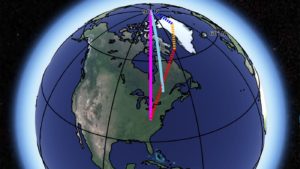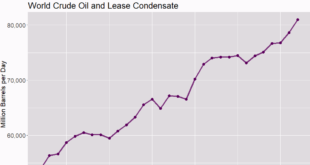
NASA’s Vital Signs of the planet post, Scientists ID three causes of Earth’s spin axis drift (9/19/18) explains changes in the spin axis.
Earth is not a perfect sphere. When it rotates on its spin axis — an imaginary line that passes through the North and South Poles — it drifts and wobbles. These spin-axis movements are scientifically referred to as “polar motion.” Measurements for the 20th century show that the spin axis drifted about 4 inches (10 centimeters) per year. Over the course of a century, that becomes more than 11 yards (10 meters).
In general, the redistribution of mass on and within Earth — like changes to land, ice sheets, oceans and mantle flow — affects the planet’s rotation. As temperatures increased throughout the 20th century, Greenland’s ice mass decreased. In fact, a total of about 7,500 gigatons — the weight of more than 20 million Empire State Buildings — of Greenland’s ice melted into the ocean during this time period. This makes Greenland one of the top contributors of mass being transferred to the oceans, causing sea level to rise and, consequently, a drift in Earth’s spin axis.
The article explains why the Greenland Ice sheet has such an impact. NASA has also produced an interactive simulation on how different processes contribute to the wobble. There could be a nice vector calculus, linear algebra, or geometry exercises here.
